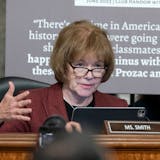Early investments in workforce development in Minnesota's tribal communities are paying off in employment — and acceleration of solar energy.
"There's plenty of opportunity for tribal nations to save the planet," said Robert Blake, a member of the Red Lake Band of Chippewa. "Its incumbent upon us. We have [Indigenous] communities taking charge of their own energy."
Duluth-based Minnesota Power has struck partnerships with the Red Lake and White Earth nations of northern Minnesota.
Blake, 47, a veteran financial services professional, is the founder of for-profit Solar Bear and nonprofit developer Native Sun. The Red Lake tribe, with Blake's organizations, started an apprenticeship program a couple of years ago with Minnesota Power, as part of an agreement to let a power line cross its reservation.
Minnesota Power, hungry for more clean energy and trained workers, is working to develop projects and train tribal members as solar installers, electricians and more.
Red Lake has built solar arrays atop key buildings and is looking to expand as it gains expertise and capacity. A key ally of Blake is Ralph Jacobson, 70, a 33-year pioneer of Minnesota solar. He retired from IPS Solar, which he founded in 1991, after its 2020 acquisition by Smart Pitch, a private-equity firm focused on renewable energy. He remained a minority shareholder until publicly held Allete, the Duluth-based holding company that owns Minnesota Power, bought Smart Pitch this year.
Jacobson, a materials scientist from St. Paul, has dedicated himself to spreading solar to tribal reservations. He also raised $400,000 in private, low-cost capital for the inaugural Red Lake solar demonstration projects. He's also assisting north Minneapolis-based Renewable Energy Partners, which has raised several million dollars to turn a once-vacant, 22,000-square-foot building into a renewable energy-producing education and training center.
Jacobson's mission is to spread the environmental and economic benefits of solar to low-income communities.


